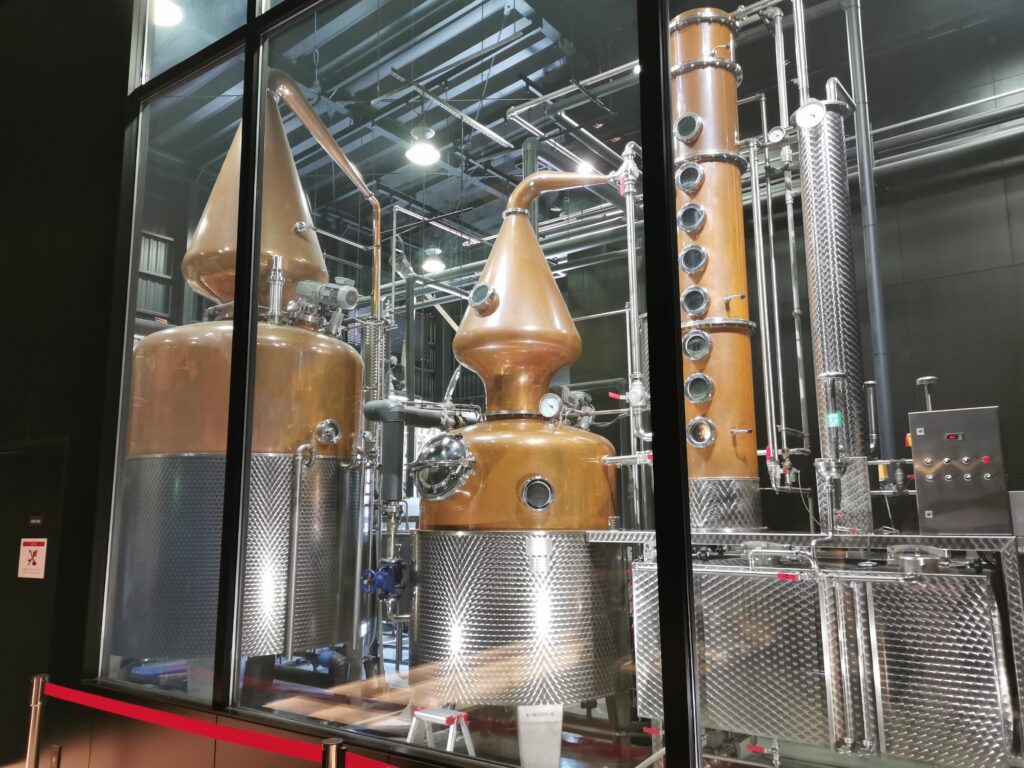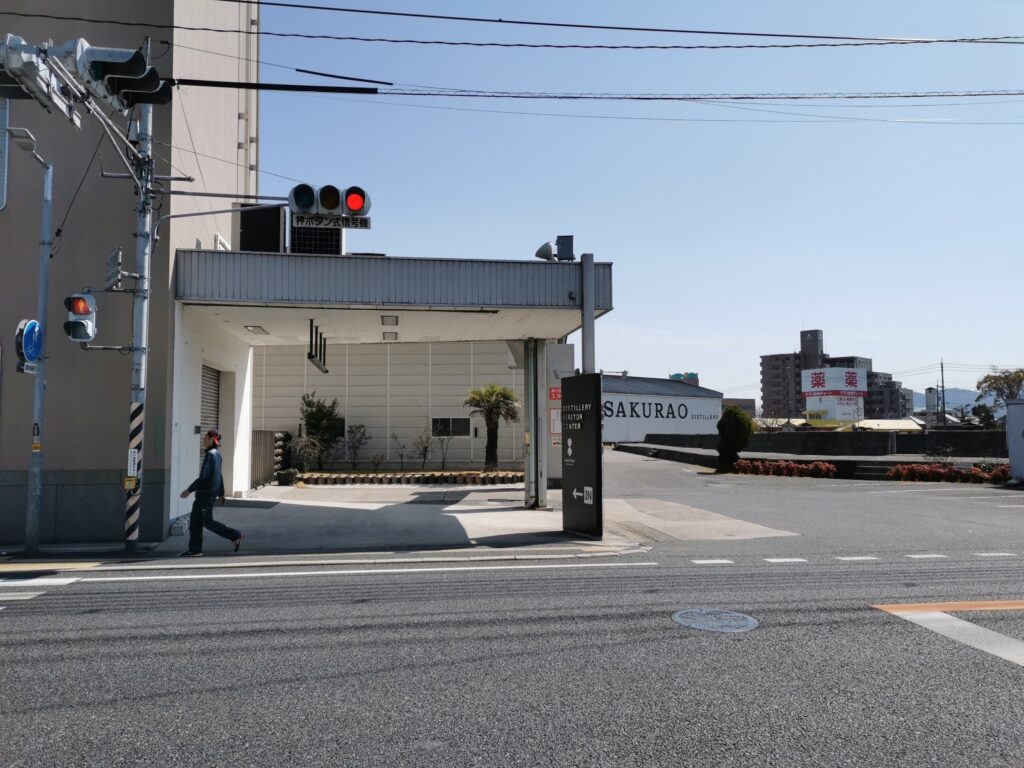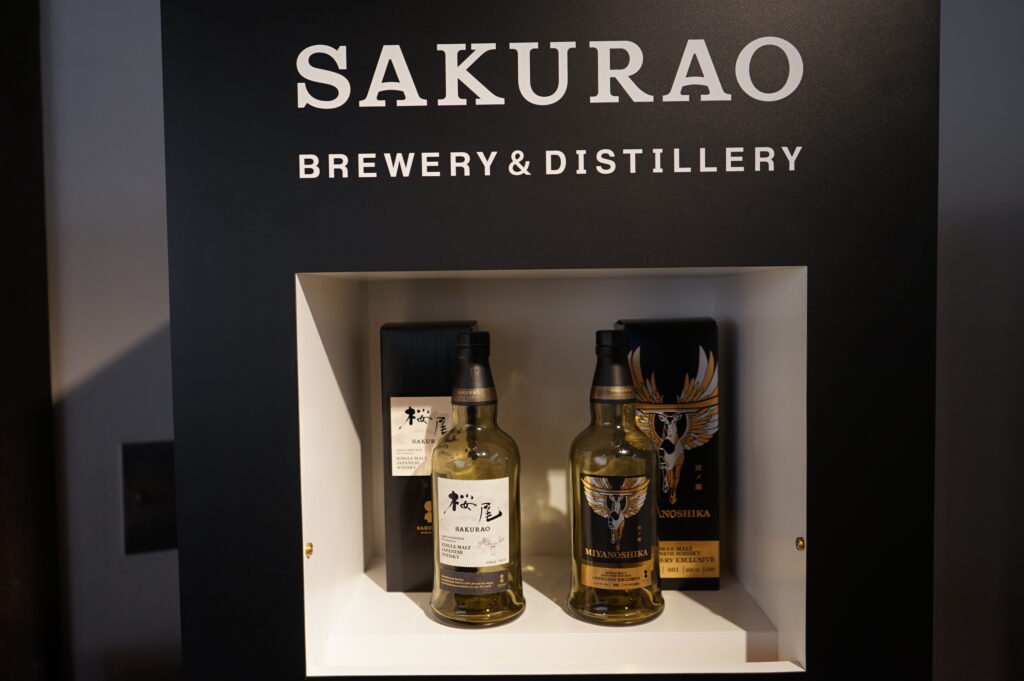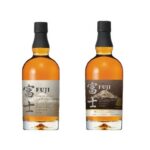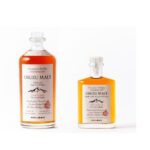When you hear the name “Sakurao,” the impression of a whisky maker has taken hold over the past few years, but for bartenders and gin drinkers, the impression of “Sakurao Gin” is probably stronger.
They operated a whisky distillery in 2017, and for three years until they were ready to ship as whisky, they concentrated on production and aging, not releasing any new makes or new bones.
Taking a cue from the British gin “Sipsmith,” they worked on the production of “craft gin,” which was still rare in Japan at that time, and they were vigorously engaged in production, sales, and promotion by utilizing the distillers they had installed.
Currently, Sakurao Distillery is continuing to expand its business, changing its name to “Sakurao Brewery and Distillery (formerly China Brewery)” in 2021, with an eye to full-scale overseas expansion. We visited the distillery on March 19, 2023 to see the production site of Single Malt Sakurao, Single Malt Togouchi, and SAKURAO GIN ORIGINAL, and to experience the latest Sakurao’s production process, such as how it is made, what it is made of, and what it is made to smell like.
1. How to get to the distillery from Tokyo
The nearest station to the Sakurao Distillery is “Hatsukaichi Station”, a 30-minute train ride further from Hiroshima Station.
| Name |
Sakurao Brewery and Distillery Co. Sakurao Distillery |
| Location | 1-12-1 Sakurao, Hatsukaichi City, Hiroshima 738-8602, Japan |
We departed from Tokyo,
(1)Approximately 4 hours to Hiroshima Station by Tokaido Shinkansen
↓
(2)Approximately 30 minutes transferring to JR Sanyo Honsen Line toward Iwakuni
↓
(3)Approximately 15 minutes on foot after arriving at Hatsukaichi Station, you will arrive at the Sakurao Distillery
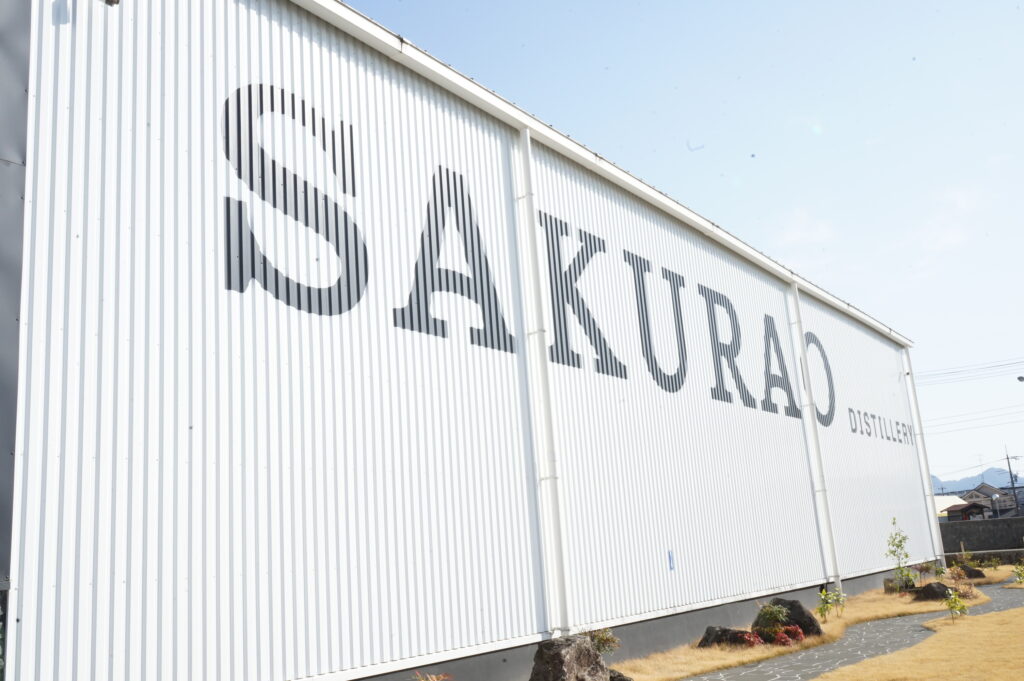
2. History of whisky making
Although the Sakurao Distillery started operation in 2017, the history of whisky making as Sakurao B&D (formerly China Brewing) actually dates back to 1920.
2-1. Whisky production license obtained in 1920
Sakrao B&D obtained a whisky production license in 1920, before the Yamazaki Distillery, the first whisky distillery in Japan, was in operation. (It was the second after Eigashima Shuzo.)
There are no documents left about the whisky production at that time, and there is no exact record of what kind of whisky they were making, but in 1958, they reinforced their whisky production facilities and started full-scale whisky production. The brands sold at that time were “Glory Whisky” and “Heart Whisky”.

You can see the early pot stills that would have been used for whisky production when you walk around the grounds of the Sakurao Distillery. Even though there was not much information about whisky production at that time, when we see the fact that such pot stills were developed and used to produce whisky, we feel greatness and gratitude toward our ancestors.
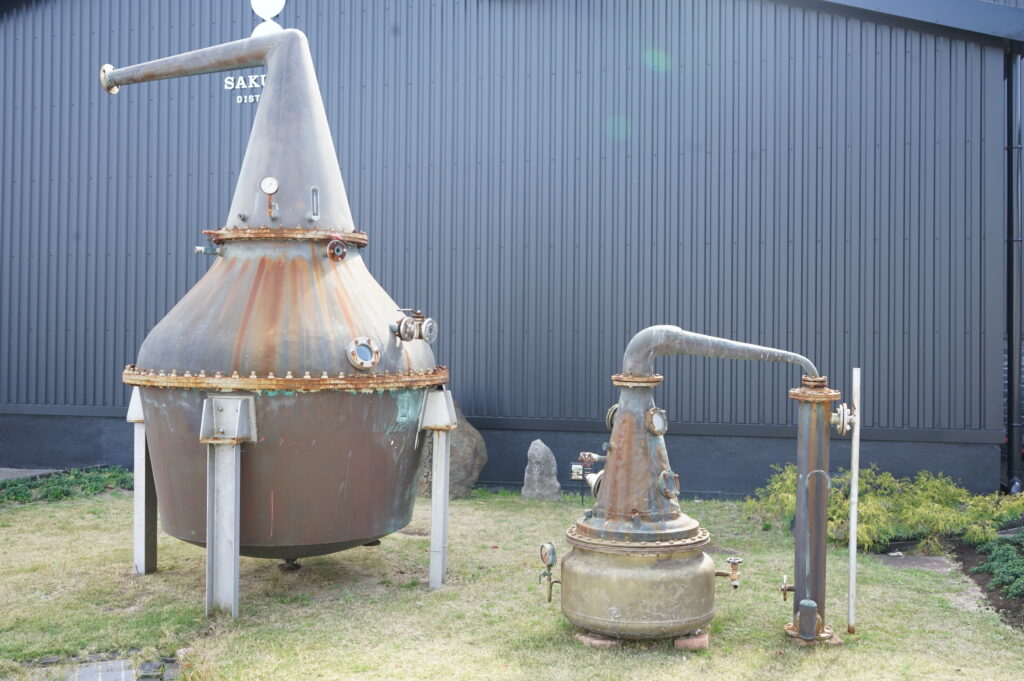
2-2. 2006, Togouchi Whisky is released
After a long time, in 2006, the whisky that had been produced and stored in the past was found, and “Togouchi Whisky” was released as a blended whisky blended with imported overseas original whisky.
Since the whisky produced in the past would eventually run out, the company decided to produce its own whisky and started operation of the Sakurao Distillery in 2017. It appears that the current Blended whisky Togouchi plans to eventually shift to production with its own malt and grain.
2-3. Overseas training and Sakurao Gin
When they started whisky production, it was difficult to conduct training in Japan, so they visited several distilleries in Scotland and the U.S. to see the actual whisky making process and to plan what kind of production equipment they would introduce.
He saw a gin called “Sipsmith” being sold at an airport in England at the time, and foresaw a craft gin boom in Japan in the future, so he decided to produce and sell Sakurao Gin in addition to whisky production.
In 2017, the Sakurao Distillery finally started operations, but we did not find any information on their website that they were producing whisky, and most of the PR was only about Sakurao Gin.
The distillery was producing a considerable amount of whisky from the first year, but since the product they were selling was Sakurao Gin, the initial publicity seemed to be focused on Sakurao Gin only.
2-4. Company name changed to Sakrao B&D
In March 2021, the company name was changed from China Brewing to Sakurao Brewery and Distillery. Then, on July 1, 2021, the first release of Sakurao Distillery’s whisky, “Single Malt Sakurao (Cask Strength)“and “Single Malt Togouchi (Cask Strength)“.
https://en.jpwhisky.net/2021/06/07/new_singlemalt_sakurao_togouchi-2/
Today, Western liquors, including whiskies, spirits, and liqueurs, account for about 70% of sales. Until then, the company’s main sales were “mirin (sweet cooking sake)”, “shochu (distilled spirit)”, and “synthetic sake”, but due to price competition, performance was poor and the company’s survival was at times in jeopardy.
After overcoming various hardships, Sakrao B&D sees potential in the Western-style alcohol and whisky business, and is looking to further expand exports to overseas markets.
3. Production site and facilities
The Sakurao Distillery is composed of four major sections: “SAKURAO No.1”, “SAKURAO No.2”, “SAKURAO WAREHOUSE”, and the “Togouchi Tunnel”.
3-1. SAKURAO No.1 (malt whisky and gin)
“SAKURAO No.1” produces malt whisky and gin.
One ton of malt is used per brewing. The mill used to grind the malt is made by Buhler of Switzerland. Malt is imported from Scotland and Australia.

The ratio of malt milled is 2 (husk) : 6.5 (grits) : 1.5 (flour).
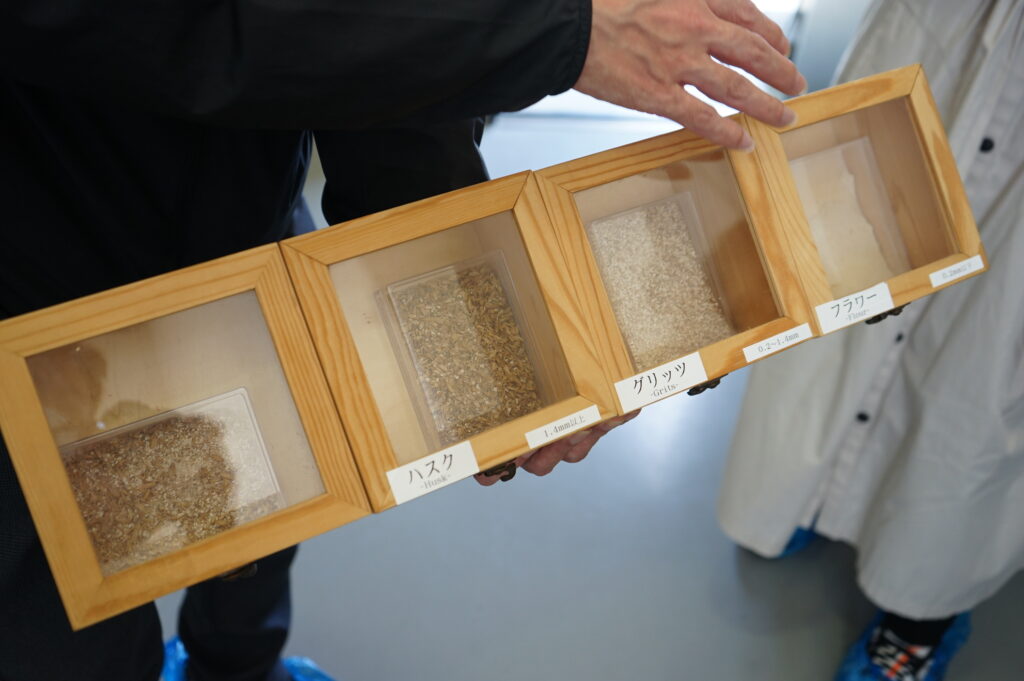
The mash tun and stainless steel fermentation tanks used for saccharification are made by Barbarian in Hungary. Water and yeast are added to the mash tan for saccharification, and the mixture is transferred to stainless steel fermentation tanks for fermentation for approximately 3 days.
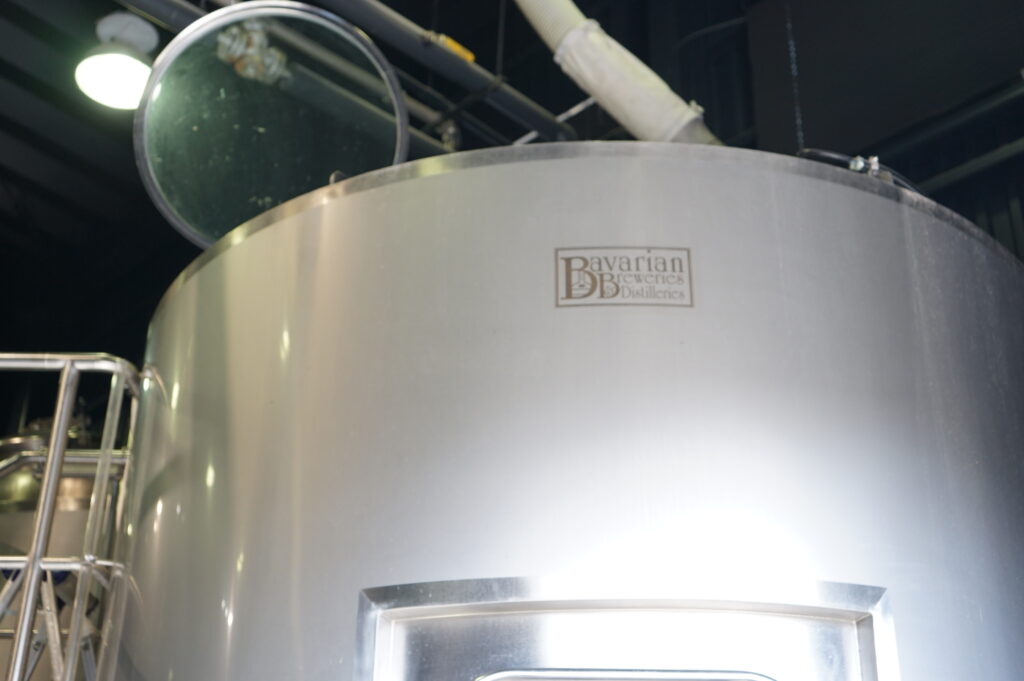
The distiller uses a hybrid still made by Holstein in Germany. Sakurao Gin also uses this Holstein hybrid still. Sakurao uses the hybrid still as a facility that can switch to the production of other products in anticipation of a decline in sales and production volume after the gin and whisky boom.
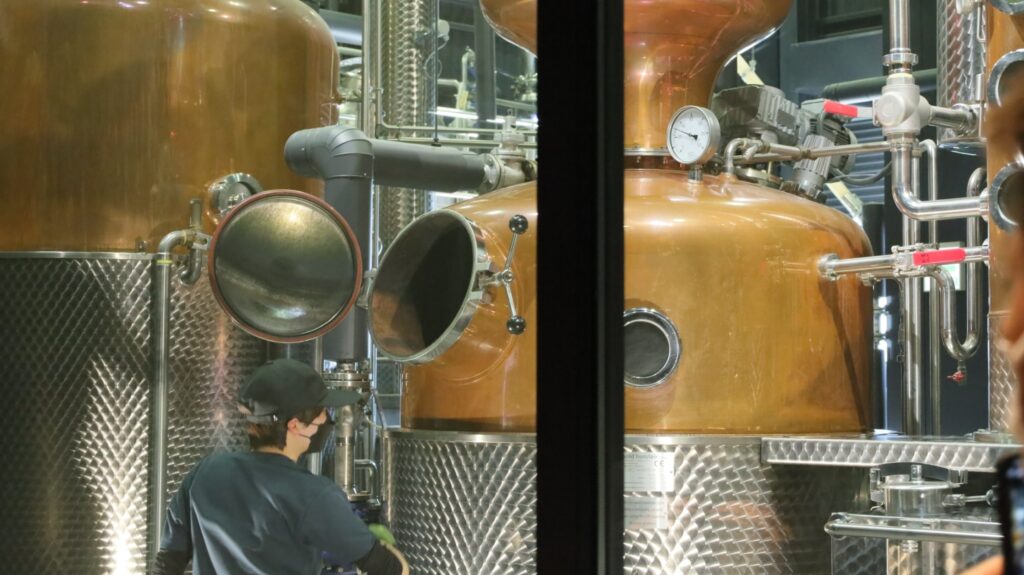
The Holstein distiller used for the first distillation is one of the largest in Japan. Before the introduction of this equipment, the distillation was carried out by dividing the mash after fermentation into several distillations; since the first distillation can be carried out in one go, the efficiency has improved considerably. In the redistillation process, the columns are used to create various flavors and aromas, and the distillery aims to create an esteemed aroma of the original sake.
3-2. SAKURAO No.2 (grain whisky)
“SAKURAO No.2” produces grain whisky.
The number of Japanese craft distilleries producing grain whisky is increasing. In addition to malt whisky, the “Kanosuke Distillery” in Kagoshima also produces 100% barley grain whisky at the Hioki Jyoryugura. “Yoshida Denzai Distillery” in Niigata produces 100% corn as a distillery dedicated to grain whisky.
The Sakurao Distillery uses a 10:1 ratio of domestic barley and imported malt. The barley is milled in the same ratio with a hammer mill, saccharified with hot water, and then sent directly to the fermentation tank without filtration. After about 3 days of fermentation, the mash is transferred to a distiller for distillation.
In the distillation process, a decompression distillation method is used to lower the boiling point (40 degrees Celsius) and extract the alcohol to prevent the sludgy mash from being burnt. The distiller for the first distillation is made of stainless steel because copper distillation dents the distiller during decompression distillation. The second distillation is done by atmospheric distillation to raise the alcohol content. At the Sakurao Distillery, both malt and grain whiskies are distilled by indirect steam distillation. The water used is reduced as much as possible, with the goal of producing whisky with high sugar content and environmental friendliness.
3-3. SAKURAO WAREHOUSE
In the Sakurao Distillery’s onsite maturing warehouse, “SAKURAO WAREHOUSE,” various types of barrels are used to store the original whisky. Malt whisky is stored horizontally and grain whisky vertically. Here, the whisky is matured as whisky over a long period of time.
Angel’s share is an essential part of the whisky maturation process, and at the Sakurao Distillery, the story is set up so that an angel named “Miyanoshika” drinks the original whisky and decreases as an angel’s share.

The malt whisky was stored in a dunnage style, stacked up to four tiers. When arranging the barrels, the SAKURAO mark is fine-tuned so that it lines up nicely, and every detail is taken care of.
The casks used in the Togouchi Tunnel are being reused, but the mold on the wood and the rust on the metal fittings are severe, and the humid environment in the Togouchi Tunnel was well understood by the condition of the casks after they were used.
It seemed that several types of casks used for Islay whisky are also used for aging, and in the cellar, cherry tail packed in casks after being used for aging “Lagavulin” was being matured. It will be very interesting to see how the Islay casks will affect the original wine.

Generally, I hear that many bourbon barrels are reused, but at the Sakurao Distillery, the barrels used at the “Heaven Hill” Distillery were in very good condition, and the barrels must have been carefully handled at the Heaven Hill Distillery. It was said.
3-4.Togouchi Tunnel (aging room)
Although we were not able to visit the distillery this time, the malt distilled at the Sakurao Distillery is also stored in the “Togouchi Tunnel” located in the mountains about an hour drive from the distillery.
In the 1970s, this tunnel was planned as part of the Imafuku Line connecting Kabe Station on the Sanyo Main Line and Hamada Station on the Sanin Main Line. The tunnel was left in its original state and was acquired and utilized as a storage facility.
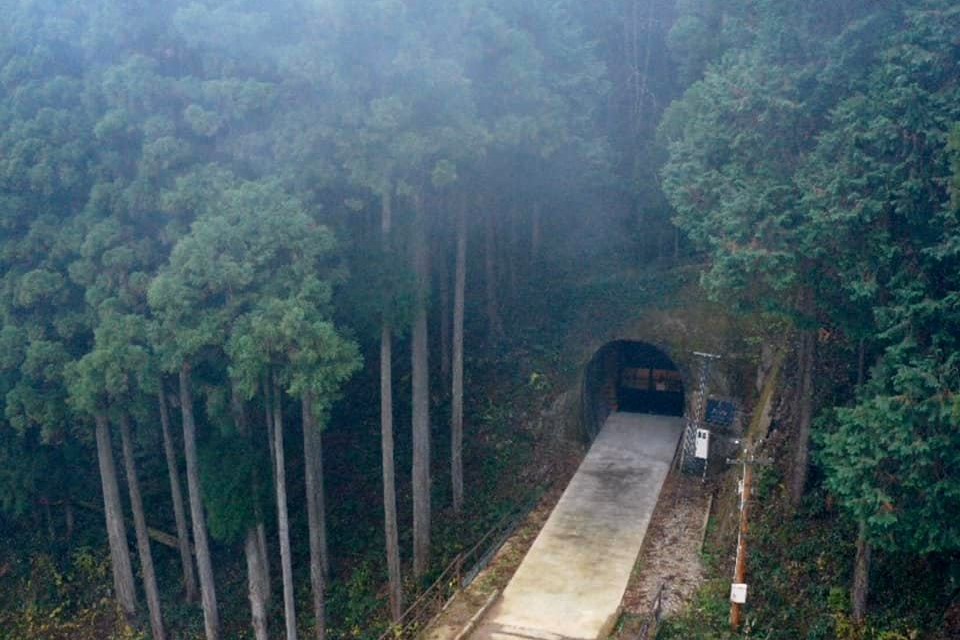
(Image source: SAKURAO DISTILLERY Facebook page)
The temperature in the tunnel is kept at 15 degrees Celsius and 80% humidity, and the wood of the barrels absorbs the moisture, which is said to be less angel’s share as it enters the barrels as water.
However, it is said that a special aging process takes place in which only the alcohol content is reduced by the moisture. Most of the sake stored in the Togouchi Tunnel is said to be non-peated.
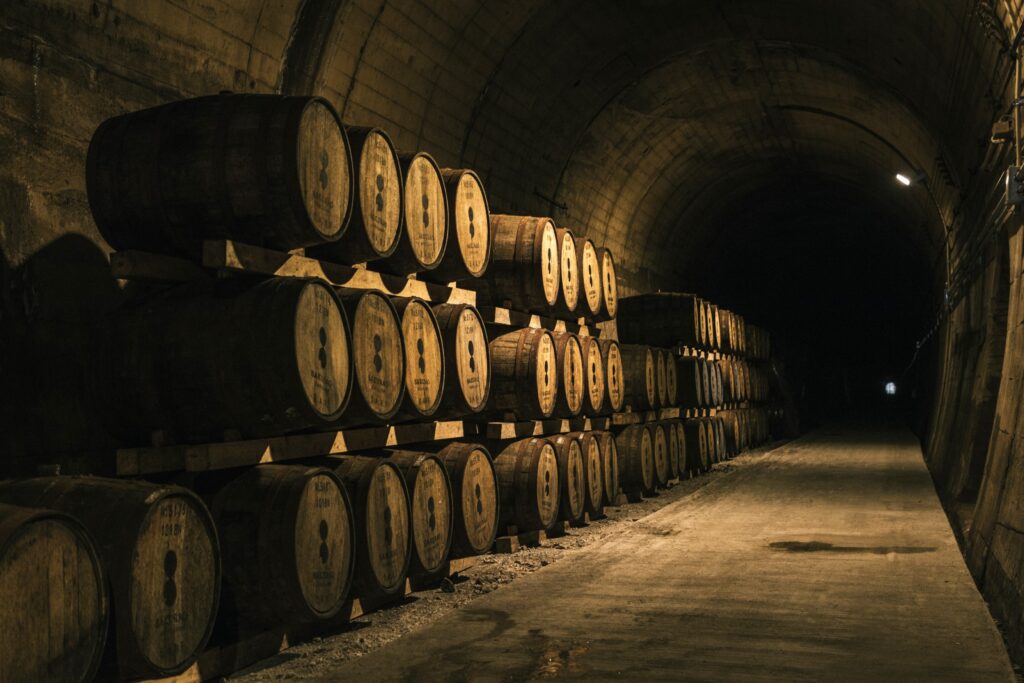
(Image source: BLENDED WHISKY | SAKURAO DISTILLERY)
4. Tasting
After a tour of the production site, it was time for the tasting.
This time, we tasted the following
- New make of Malt Whisky
- New make Grain Whisky
- Single Malt Sakurao
- Single Malt Togouchi
- Distillery limited edition MIYANOSHIKA
- 4 cask samples

The new make of Grain Whisky was offered as a free tasting by “Yoshida Denzai Distillery” at the last Japanesfest, but because the raw material is corn, the new make of Grain Whisky from Sakurao this time was completely different.

The “Single Malt Sakurao” and “Single Malt Togouchi“, which are sold as official products, have firmly different concepts. Togouchi is non-peated and gorgeous. And “MIYANOSHIKA”, a distillery exclusive, is a blend of Sakurao Malt Whisky and Togouchi Malt Whisky.
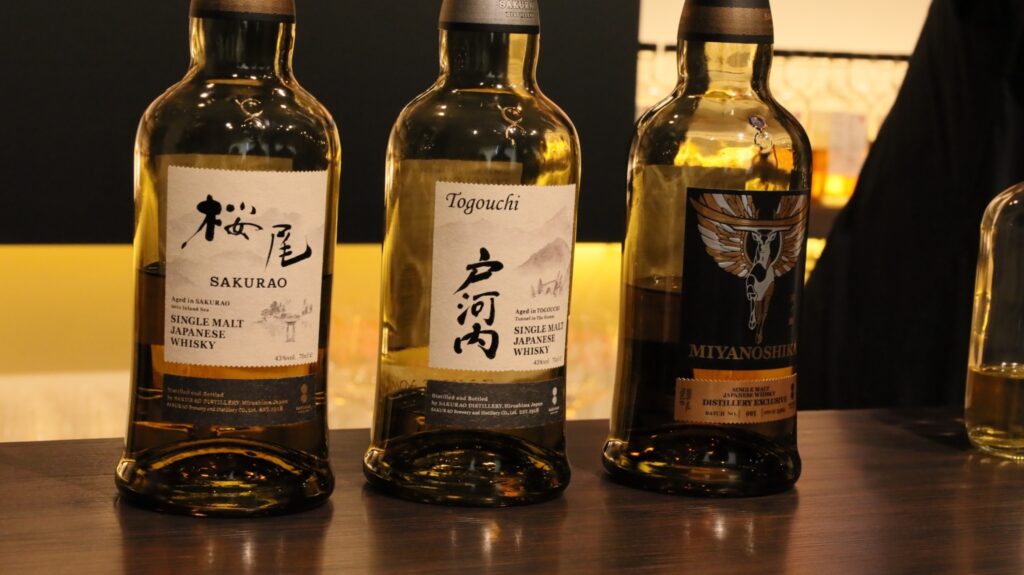
The four cask samples are made of Sakurao Malt Whisky and Togouchi Malt Whisky, aged in bourbon casks and Ardbeg casks, respectively. Comparing them, we can see that they are considerably influenced by the casks used in Ardbeg. It seems a little difficult to determine how to use this sake as a product, but it is a very interesting approach to create a variety of flavors, and I have high expectations that it will be used for limited release as a single cask.
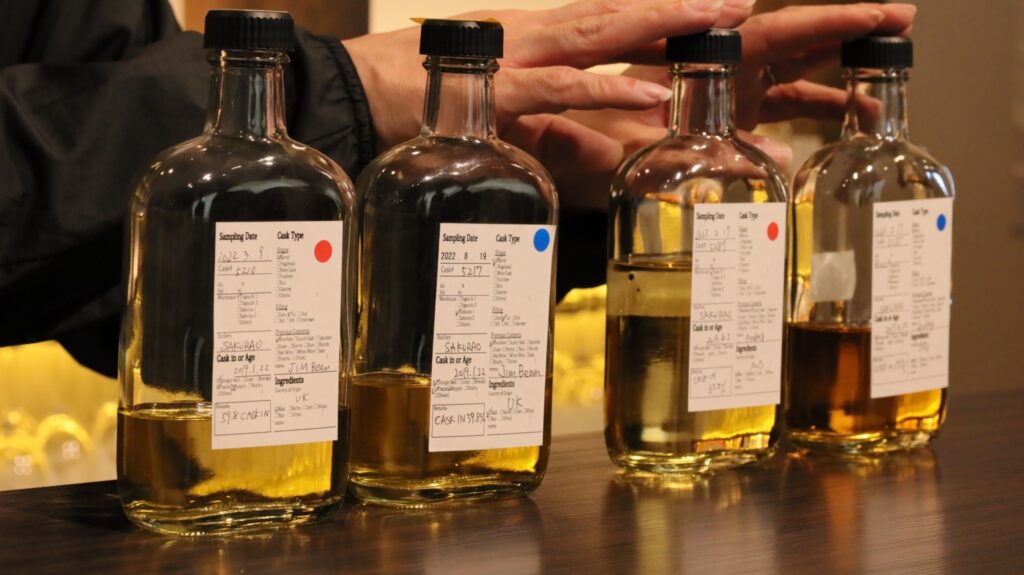
5. Shop
In the Visitor Center, there is a store where you can buy a variety of liquors and goods including Sakurao’s whisky.
One person can purchase one bottle of “MIYANOSHIKA”, which is a limited edition of the whisky produced at the brewery. Miniature bottles of Togouchi Whisky and Glory Whisky Highball cans are also available.
The Sakurao Distillery has a well-maintained visitor center, and there are several hands-on points of interest for visitors to enjoy at the production site. After the tasting, it is recommended to purchase whisky and snacks at the store attached to the distillery and enjoy the afterglow on the train ride home.
We hope you will visit the Sakurao Distillery.

